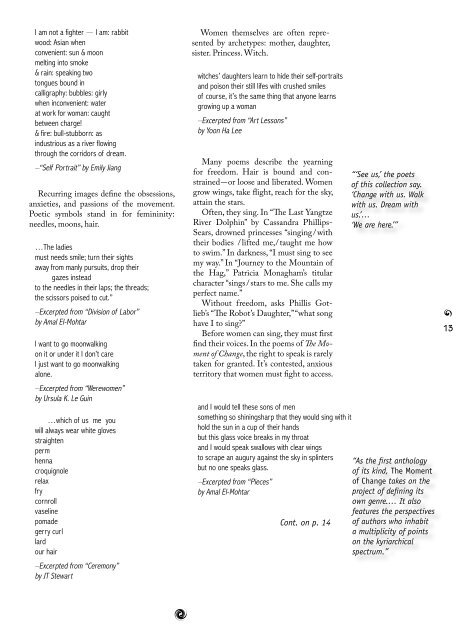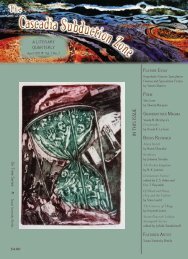Subduction
REviEwEd - The Cascadia Subduction Zone
REviEwEd - The Cascadia Subduction Zone
- No tags were found...
Create successful ePaper yourself
Turn your PDF publications into a flip-book with our unique Google optimized e-Paper software.
I am not a fighter — I am: rabbit<br />
wood: Asian when<br />
convenient: sun & moon<br />
melting into smoke<br />
& rain: speaking two<br />
tongues bound in<br />
calligraphy: bubbles: girly<br />
when inconvenient: water<br />
at work for woman: caught<br />
between charge!<br />
& fire: bull-stubborn: as<br />
industrious as a river flowing<br />
through the corridors of dream.<br />
–“Self Portrait” by Emily Jiang<br />
Recurring images define the obsessions,<br />
anxieties, and passions of the movement.<br />
Poetic symbols stand in for femininity:<br />
needles, moons, hair.<br />
…The ladies<br />
must needs smile; turn their sights<br />
away from manly pursuits, drop their<br />
gazes instead<br />
to the needles in their laps; the threads;<br />
the scissors poised to cut.”<br />
–Excerpted from “Division of Labor”<br />
by Amal El-Mohtar<br />
I want to go moonwalking<br />
on it or under it I don’t care<br />
I just want to go moonwalking<br />
alone.<br />
–Excerpted from “Werewomen”<br />
by Ursula K. Le Guin<br />
…which of us me you<br />
will always wear white gloves<br />
straighten<br />
perm<br />
henna<br />
croquignole<br />
relax<br />
fry<br />
cornroll<br />
vaseline<br />
pomade<br />
gerry curl<br />
lard<br />
our hair<br />
–Excerpted from “Ceremony”<br />
by JT Stewart<br />
Women themselves are often represented<br />
by archetypes: mother, daughter,<br />
sister. Princess. Witch.<br />
witches’ daughters learn to hide their self-portraits<br />
and poison their still lifes with crushed smiles<br />
of course, it’s the same thing that anyone learns<br />
growing up a woman<br />
–Excerpted from “Art Lessons”<br />
by Yoon Ha Lee<br />
Many poems describe the yearning<br />
for freedom. Hair is bound and constrained<br />
— or loose and liberated. Women<br />
grow wings, take flight, reach for the sky,<br />
attain the stars.<br />
Often, they sing. In “The Last Yangtze<br />
River Dolphin” by Cassandra Phillips-<br />
Sears, drowned princesses “singing / with<br />
their bodies / lifted me, / taught me how<br />
to swim.” In darkness, “I must sing to see<br />
my way.” In “Journey to the Mountain of<br />
the Hag,” Patricia Monagham’s titular<br />
character “sings / stars to me. She calls my<br />
perfect name.”<br />
Without freedom, asks Phillis Gotlieb’s<br />
“The Robot’s Daughter,” “what song<br />
have I to sing?”<br />
Before women can sing, they must first<br />
find their voices. In the poems of The Moment<br />
of Change, the right to speak is rarely<br />
taken for granted. It’s contested, anxious<br />
territory that women must fight to access.<br />
and I would tell these sons of men<br />
something so shiningsharp that they would sing with it<br />
hold the sun in a cup of their hands<br />
but this glass voice breaks in my throat<br />
and I would speak swallows with clear wings<br />
to scrape an augury against the sky in splinters<br />
but no one speaks glass.<br />
–Excerpted from “Pieces”<br />
by Amal El-Mohtar<br />
Cont. on p. 14<br />
“‘See us,’ the poets<br />
of this collection say.<br />
‘Change with us. Walk<br />
with us. Dream with<br />
us.’…<br />
‘We are here.’”<br />
“As the first anthology<br />
of its kind, The Moment<br />
of Change takes on the<br />
project of defining its<br />
own genre.… It also<br />
features the perspectives<br />
of authors who inhabit<br />
a multiplicity of points<br />
on the kyriarchical<br />
spectrum.”<br />
i<br />
13<br />
n




